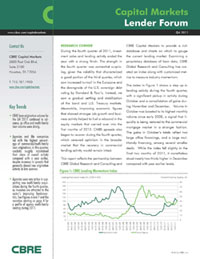Real estate prices in the Pikes Peak region seems to have stabilized, with noted acquisitions, such as Stan Kroenke's purchase of Academy Place shopping center. Vacancy rates are falling among office, industrial, and retail spaces, and home building is recovering.
Colorado Springs --(The Gazette)--
The Pikes Peak region's commercial real estate market, plagued by high vacancies and stagnant rents in recent years because of the poor economy, will continue to improve in 2014 - albeit slowly, according to a forecast by Quantum Commercial Group in Colorado Springs.
"Have we turned the corner?" asked Michael Palmer, a Quantum broker. "We've certainly turned the corner from the downturn. But I think we're in the middle of a very slow grind upwards."
Improvement in the market will be fueled by interest in Colorado Springs on the part of investors, developers and retailers; trickle-down benefits from commercial activity in Denver and other markets; and a better jobs picture, Quantum officials said.
"It's slow growth across all the sectors," Quantum president Dale Stamp said of the office, retail, industrial and land markets. "It's positive. You've got an air of confidence in the entire city."
Colorado Springs already has seen investments from some high-profile out-of-towners, such as this year's purchase of the Academy Place shopping center at Academy and Union boulevards by a company controlled by billionaire real estate and sports mogul Stan Kroenke, said Quantum broker Susan Beitle. At the same time, a Kroenke real estate development continues to plan a new retail center in Monument, she said.
"Those are two good examples of money coming into Colorado Springs," said broker Andy Oyler.
A strong Denver economy has driven up real estate prices there, prompting some investors to turn to the Springs as an attractive secondary market where they can get solid returns on their investments, Palmer said.
"Colorado Springs is seeing the benefit of that," Palmer said. "That's why there's activity, just because it's a better value market right now than some of the others."
According to Quantum's 2014 forecast:
- The vacancy rate for office space fell late this year to a little less than 11.5 percent, down from nearly 20 percent in 2009. An additional 560,000 square feet of office space was occupied, or absorbed, this year - more than double the annual absorption average over the last five years. And lease rates of $17.11 per square foot were up slightly from the five-year average of $16.36.
In 2014, Quantum expects another slight decline in the area's vacancy rate, while absorption and lease rates will continue to rise slowly.
- Industrial vacancy rates fell to 8.4 percent this year after being near 14 percent a few years ago. Although the Department of Defense budget remains a concern, Quantum officials believe the industrial vacancy rate could drop below 7 percent in 2014.
- The local retail vacancy rate improved only slightly by year's end to 6.8 percent from 6.9 percent a year ago. The rate will remain relatively unchanged in 2014, according to the forecast, although the amount of space that will be occupied will rise next year over 2013.
- As homebuilding recovered, sales of land for residential development increased sharply in 2013 and will continue in 2014.

